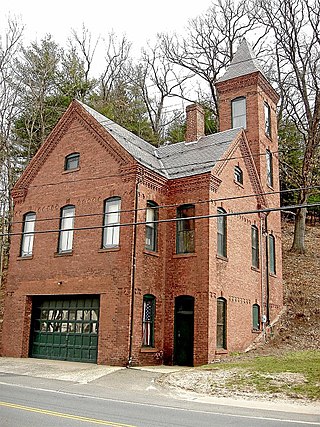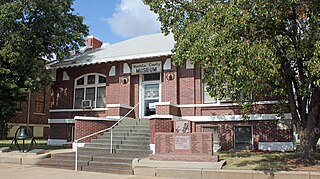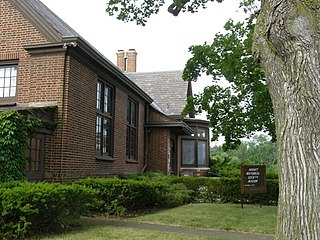
The Central Library is the main branch of the Somerville, Massachusetts, public library system. It is an architecturally distinguished Renaissance Revival brick building designed by Edward Lippincott Tilton and was built in 1914 with funding assistance from philanthropist Andrew Carnegie. The building was listed on the National Register of Historic Places in 1989.

Taunton Public Library is the public library of Taunton, Massachusetts. It is located at 12 Pleasant Street, in an architecturally distinguished Beaux Arts building built in 1903 with funding support from Andrew Carnegie, to which a modern addition was made in 1979. The building is listed on the National Register of Historic Places as a particularly fine local example of Beaux Arts architecture.

The Levi Heywood Memorial Library Building is an historic library building at 28 Pearl Street in Gardner, Massachusetts. Completed in 1886, it is one of the city's most architecturally distinguished buildings, and a good example of Richardsonian Romanesque design. It was given in honor of Levi Heywood, a prominent figure in the city's economically important chair manufacturing industry. It was used as a library until 1978, and now houses a museum dedicated to the city's history. The building was listed on the National Register of Historic Places in 1979, and included in the Gardner Uptown Historic District in 1999.

The Tunxis Hose Firehouse is an historic firehouse at Lovely Street and Farmington Avenue in the center of Unionville, Connecticut. BUilt in 1893, it is a well-preserved example of a late 19th-century rural firehouse with Queen Anne Victorian features. The building was listed on the National Register of Historic Places on July 28, 1983. It presently houses a muster vehicle for Tunxis Hose Company No. 1, a local volunteer fire company.

The Cary Library is the public library of Houlton, Maine, US. It is located at 107 Main Street, in an architecturally distinguished building designed by John Calvin Stevens. The building was added to the National Register of Historic Places in 1987. The library opened on October 12, 1904.

The Milo Public Library is located at 121 Main Street in Milo, Maine, USA. It is located in a small, architecturally distinguished building, built with funding assistance from Andrew Carnegie. The building was added to the National Register of Historic Places in 1989.

The Bayonne Public Library is the free public library of Bayonne, New Jersey. Incorporated in 1890, it serves a population of approximately 69,000.

The Smith County Historical Society, housed in the Carnegie Library, is located at 125 S. College Street in the city of Tyler, Smith County, Texas, U.S. It was built in 1904 as the Carnegie Public Library, and added to the National Register of Historic Places listings in Smith County, Texas in 1979. When Tyler built a new public library, the Carnegie building was leased to the Smith County Historical Society and continues to operate as a museum and archives.

The Lincoln Branch Library is a former Carnegie library building in the Lincoln Park neighborhood of Duluth, Minnesota, United States. It was constructed from 1915 to 1917 as the first permanent home of a Duluth Public Library branch first established in 1892. The Lincoln Branch Library was built of brick and limestone in the Late Gothic Revival style. It was the last of the three Carnegie libraries built in Duluth.

The historic Duluth Public Library is a former Carnegie library building at 101 West Second Street in Duluth, Minnesota, United States. It was constructed in 1902 as the first purpose-built facility of the Duluth Public Library. It was listed on the National Register of Historic Places in 1978 for its local significance in the themes of architecture and education. It was nominated for its Neoclassical architecture and association with early community education efforts.

The Fletcher Free Library is the public library serving Burlington, Vermont. It is located at 235 College Street, in an architecturally distinguished Beaux-Arts building, constructed in 1902 with funding support from philanthropist Andrew Carnegie. The building was listed on the National Register of Historic Places in 1976.

The Cordell Carnegie Public Library is a historic Carnegie library located at 105 E. First St. in New Cordell, Oklahoma. The library was built in 1911 through a $10,000 grant from the Carnegie foundation; New Cordell's Commercial Club, which had opened a reading room the previous year, solicited the grant. Architect A. A. Crowell designed the library in the Mission Revival style; several of its elements reflect the emerging Spanish Colonial Revival style. The building's curved parapet walls, exposed rafters, and original red tile roof are all characteristic Mission Revival elements; its segmental arches, sunburst moldings, and ornamental ironwork resemble Spanish Colonial Revival work. The library was the only one in Washita County until the 1960s; it also served as a community center and was regularly used by local schools. In 1982, a new library opened in New Cordell, and the Carnegie Library building became the Washita County Historical Museum.

Goshen Carnegie Public Library, also known as the Goshen Public Library, is a historic Carnegie library located at Goshen, Elkhart County, Indiana. It was built in 1901, and is a 1+1⁄2-story, Beaux-Arts style building clad in Bedford limestone. It has a red tile roof and projecting entrance pavilion with two Tuscan order columns. Its construction was funded with $25,000 provided by the Carnegie Foundation.

Hobart Carnegie Library, also known as the Hobart Historical Society Museum, is a historic Carnegie library located at Hobart, Lake County, Indiana. It was built in 1914-1915, and is a one-story, Tudor Revival style brick building. The building has a high-pitched slate gable roof and a polygonal bay with leaded glass windows and entry porch. The building was constructed with a $16,000 grant from the Carnegie Foundation.
The Vinalhaven Public Library is the public library serving the island community of Vinalhaven, Maine. It is located at 6 Carver Street in downtown Vinalhaven, in a small architecturally distinguished Prairie School building built in 1906 with financial support from Andrew Carnegie. The building was listed on the National Register of Historic Places in 1989.

The Sioux City Free Public Library is a historic building located in Sioux City, Iowa, United States. The library was located in a section of the Municipal Building, no longer extant, between 1892 and 1913. It had outgrown the space when the Library Board contacted Andrew Carnegie in 1910 about providing the funding for a new library building. Their request was initially turned down. They chose to work with New York City architect Edward L. Tilton, an architect preferred by Carnegie, in place of local architect William L. Steele who was working with the board previously. Local resident George Murphy donated the property for the new building. Meanwhile, Tilton designed the two-story brick Renaissance Revival building. On April 8, 1911, Carnegie approved the project and donated $75,000 for the building's construction. The new building was dedicated on March 6, 1913, and it is considered "an excellent early twentieth century example of the architectural development of library planning and design." It was Tilton's only building in Iowa.

The Gridley-Parson-Staples House is a historic house museum at 1554 Farmington Avenue in Farmington, Connecticut. Probably built about 1760, it is the oldest surviving house in northwestern Farmington, and a fine example of 18th century Georgian architecture. It is now home to the Farmington Historical Society, and was listed on the National Register of Historic Places in 1981.

The Congregational Church of Plainville is a historic church building at 130 West Main Street in Plainville, Connecticut. Built in 1850, it is one Connecticut architect Henry Austin's significant church designs, exhibiting a mix of Carpenter Gothic and Romanesque features. It was built for a congregation formally organized in 1839 that is now affiliated with the United Church of Christ. The church was listed on the National Register of Historic Places in 2012.




















